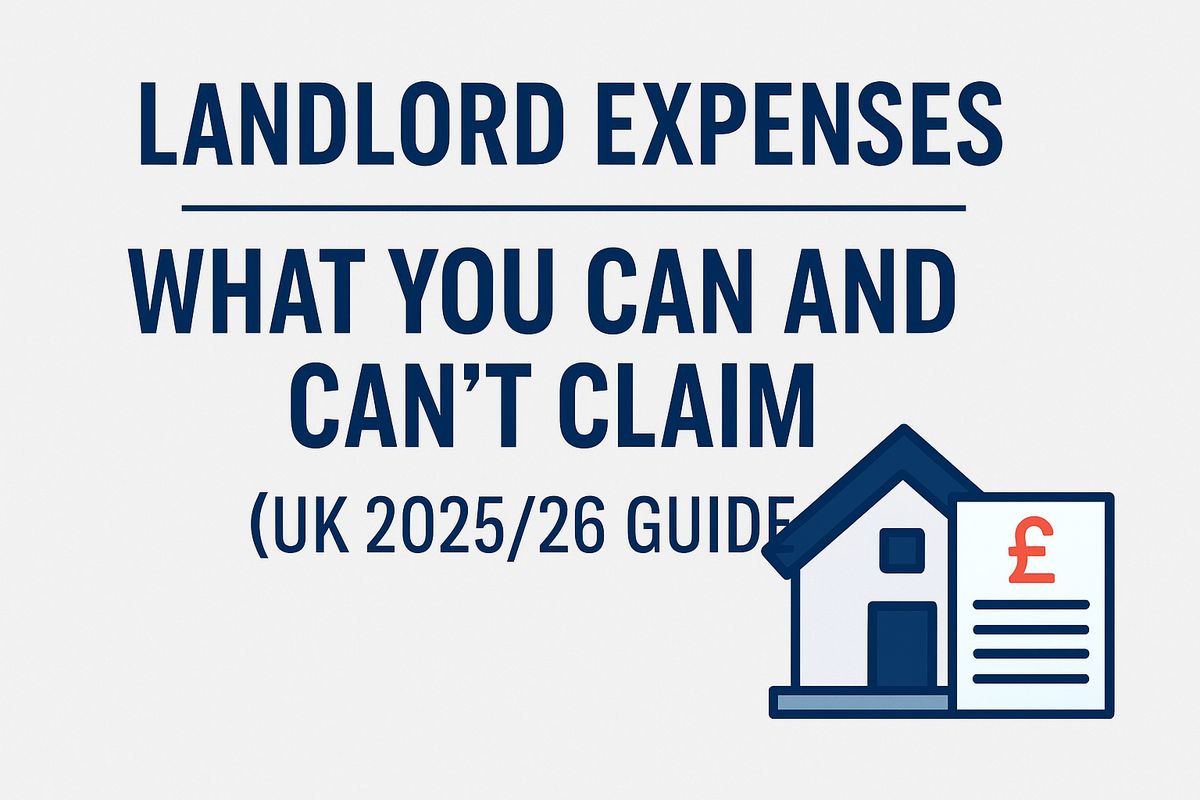Many Landlords either under-claim and pay more Tax than necessary, or over-claim and risk HMRC rejecting expenses.
The rules are clear once you understand what HMRC class as Revenue expenses (allowed now) and Capital costs (allowed later for CGT).
🎥 If you prefer to watch rather than read, here is the full video guide.
You can now continue with the full written guide below.
This guide sets out what you can and can’t claim as a Landlord in 2025/26, plus the common mistakes to avoid.
It applies to:
- Single-property Landlords
- Multi-property portfolios
- Rent-to-rent operators
- UK and overseas Landlords
- Joint owners and Partnerships
1. Allowable Landlord Expenses (HMRC Accepts These)
These are day-to-day running costs.
✔ Mortgage interest (Section 24 rules)
- Individuals receive a 20% tax credit, not a full deduction.
- Companies can claim the full amount.
✔ Repairs and maintenance
Work that keeps the property in working order, without improving it.
Examples:
- Fixing leaks
- Repainting
- Replacing broken fixtures
- Boiler repairs
- Roof patching
- Replacing like-for-like carpets, appliances or fittings
👉 If an item is replaced with a higher-spec version, part may be treated as Capital — see Section 3.
✔ Letting Agent fees
- Tenant find fees
- Management fees
- Rent collection fees
Fully deductible.
✔ Service charges & Ground rent
If the property is leasehold.
✔ Insurance
- Landlord insurance
- Buildings and contents
- Public liability
- Rent guarantee insurance
✔ Accountancy fees
If related to the rental business.
✔ Utilities & Council Tax
Where paid by the Landlord (e.g., HMOs, Rent-to-Rent).
✔ Advertising and Tenant replacement
Marketing the property, online ads, board signs.
✔ Mileage and Travel
Travel for property management:
- 45p per mile (first 10,000 miles)
- 25p per mile afterwards
Records must be kept.
2. Replacement of Domestic Items (RDE Relief)
RDE applies when you replace household items in a furnished or part-furnished rental.
You can claim:
- Beds and mattresses
- Sofas and chairs
- Wardrobes
- Carpets, curtains, blinds
- Fridges, freezers, washing machines, microwaves
- Lamps, TVs
- Kitchenware (pots, pans, plates, cutlery)
- Delivery and disposal costs
Key rules:
- Must be a replacement, not the initial furnishing.
- If the new item is an upgrade, you can only claim the cost of a like-for-like replacement.
- RDE applies to individual Landlords, not Limited Companies.
3. Capital Improvements vs Repairs (Where Most Landlords Go Wrong)
Revenue Expense (allowed now)
Fixing something back to its original condition.
Capital Improvement (not allowed now)
Enhancing, upgrading, extending or improving the property.
Examples of Capital Improvements:
- Extensions
- Loft conversions
- Replacing single glazing with double glazing
- Upgraded kitchens or bathrooms
- Structural changes
- First-time refurbishment before the first tenant
Capital improvements are added to CGT base cost, not deducted from rental profit.
👉 See my article on Why Assumptions with HMRC often Backfire for more examples.
4. Overseas Landlords: What You Can Claim
You can claim the same allowable expenses as UK Landlords:
- Repairs
- Local taxes
- Agent fees
- Insurance
- Service charges
- Travel to manage the property
But you must follow UK rules for:
- RDE
- Capital vs Revenue
- Mortgage interest restrictions
👉 See my guide on How Foreign Income Is Taxed In The UK for more detail.
5. Expenses HMRC Commonly Reject
These are not allowable:
✘ Capital Improvements
(See Section 3.)
✘ Your own labour
You cannot charge yourself for work done on the property.
✘ Initial Refurbishment before letting
Making the property rentable is Capital.
✘ Personal expenses
Personal Amazon orders, shopping, meals.
✘ Clothing
Including workwear, unless it is Protective Safety Gear.
✘ Fines or penalties
Parking fines, licensing penalties, or late fees.
6. Special Cases
✔ Home office (apportioned)
A reasonable proportion for admin time.
✔ Legal fees (some allowed, some not)
Allowed:
- Section 21 / Section 8 notices
- Debt recovery
- Lease renewals under one year
Not allowed:
- Buying or Selling a property
- Remortgage costs
✔ Subscriptions & Software
Landlord associations, management software, training linked to the rental business.
7. Common Mistakes (2025 Update)
I see these repeatedly:
- Claiming Improvements as Repairs
- Forgetting the Section 24 mortgage rule
- Not claiming Service charge deductions
- Failing to separate Personal and Business spending
- No mileage logs
- Claiming furniture for unfurnished tenancies
- Recording “Cash jobs” with no evidence
- Over-claiming when the property is empty
- Under-claiming because Receipts were lost
These mistakes increase the chance of HMRC enquiries.
8. When to Get Professional Help
You may need help if:
- You have multiple properties
- You’re unsure if something is Capital or Revenue
- You have overseas rental income
- Service charges and repairs are confusing
- Records are incomplete
- HMRC has questioned past Returns
A structured review ensures your claims are accurate and defensible.
Final Word
Landlord expenses can be straightforward once you understand the difference between Repairs, Replacements and Capital improvements.
Good records and correct classifications can save you Tax — and reduce the risk of HMRC rejecting your claims.
If you’d like help reviewing your rental expenses before filing your Return, you can contact me to discuss next steps.
